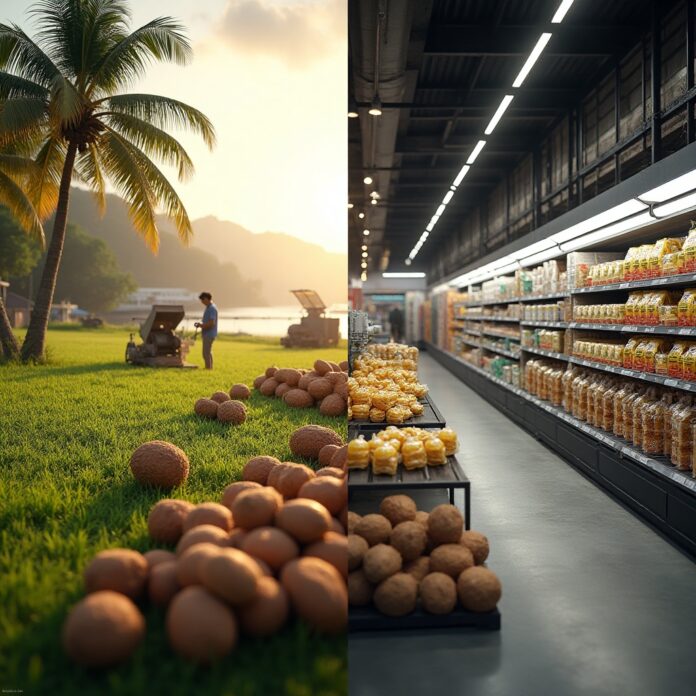Let’s talk coconuts. Not the ones you sip lazily on a beach, but the ones fueling a $20+ billion global industry. Coconut oil and chips aren’t just pantry staples anymore—they’re goldmines for food and beverage producers. Why? Health-conscious consumers are ditching seed oils for virgin coconut oil, and snackers are trading potato chips for crispy, guilt-free coconut flakes. But here’s the catch: Scaling production isn’t as breezy as a tropical vacation. Between sourcing quality raw materials, juggling equipment costs, and dodging export landmines, the path to profitability is riddled with husks (pun intended). Let’s cut through the noise.
Sourcing Raw Materials: Quality, Cost, and Sustainability
First rule of coconut business: Your product is only as good as your raw materials.
- Where to Source: The Philippines, India, and Indonesia produce 70% of the world’s coconuts (FAO 2023). Mature coconuts (12+ months old) yield richer oil, while younger ones (6-8 months) are sweeter for chips. Partner with cooperatives—they’re your ethical shortcut to traceability.
- Cost Realities: Prices swing wildly. In 2023, a ton of mature coconuts cost $300-$500 (USDA), but El Niño-driven droughts spiked rates by 20% in key regions. Lock in contracts during harvest seasons (July-September in Southeast Asia).
- Sustainability Non-Negotiables: Buyers demand Fair Trade or Organic certifications. One pro tip: Use husks for biochar or coir mats. Waste isn’t just unethical—it’s leaving money on the table.
Equipment and Production Costs: Scaling Efficiently
Let’s get real about machinery—because this is where most startups trip. You’re not just buying tools; you’re buying time.
- Coconut Oil Gear: Cold-pressed oil demands hydraulic presses ($15k–$30k for small-scale). Expeller machines? Cheaper ($8k–$20k) but trade purity for speed. Industrial setups? Brace yourself: $100k+ for automated lines (Philippine Coconut Authority).
- Coconut Chips Kit: Semi-automated lines (slicing, drying, flavor coating) run $25k–$50k. Full automation doubles the price but halves labor—critical in regions like India, where wages rose 12% last year (World Bank).
- The Hidden Tax: Maintenance. A $10k oil press guzzles another $2k/year in parts. Skip stainless steel? Enjoy FDA rejection letters. Solar-drying cuts energy costs by 40% in sun-drenched regions like Indonesia.
- Funding Hacks: Thailand offers 15% rebates for eco-friendly setups (ASEAN Agri-Development Fund).
Navigating Export Challenges
Exporting coconut products isn’t for the faint-hearted. One misstep, and your container’s rotting in a port.
- Certification Jungle: The EU requires organic certs ($5k–$10k); the Middle East demands Halal stamps. Coconut chips need allergen labels—cross-contamination with peanuts? Game over.
- Shelf-Life Wars: Nitrogen-flushed packaging adds $0.20 per bag but extends shelf life from 6 to 12 months. Refrigerated shipping? $4k per container vs. $2k for ambient (ITC Trade Map).
- Tariff Traps: The U.S. slaps 8% on coconut oil; Europe’s kinder at 4%. ASEAN nations offer zero tariffs under trade pacts.
- Cultural Nuances: Americans want “lightly salted” chips. Japanese buyers crave wasabi-infused.
Case Studies: Success Stories and Lessons Learned
- Philippines’ Oil Triumph: CocoPure cracked Europe with solar-drying and Fair Trade certs. Their $50k loss on a failed EU pesticide shipment? Now they test every batch.
- India’s Chip Hustle: TropiCrunch used AI to optimize slicing thickness (0.3mm = perfect crunch). A broken $10k dryer mid-monsoon? Farmers crowdfunded a backup via WhatsApp.
Future Trends and Opportunities
- AI & Robots: Vision systems cut waste by 17% in Filipino factories ($5k/month software).
- Africa’s Rise: Nigeria’s coconut acreage grew 40% since 2020. Land costs $100/hectare vs. $3k in Indonesia.
- Beyond Snacks: Coconut pulp protein (65% content) rivals whey. Patents pending (NutraKernel trials).
Three pillars:
- Source Smart: Traceability isn’t optional.
- Spend Smarter: Leasing buys flexibility; automation buys time.
- Export Smarter: Certifications are your armor.
The future? Innovate or die.


